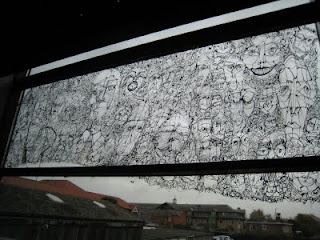
This exhibition at the Royal Academy brought together 35 artists to give a cultural response to the way that human activity is affecting the natural balance and physical cycles of the earth. I particularly enjoyed seeing several works I had read about but not seen before. These included Mona Hatoum’s Hot spot, Antony Gormley’s Amazonian Field and Cornelia Parker’s Heart of darkness. Hot spot is a stainless steel cage in the shape of a globe with the continents outlines in red neon lighting. Amazonian field consists of hundreds of clay figures packed into a room all looking towards the viewer. Heart of darkness is a hanging of shattered charcoal, the remains of a forest fire in Florida. I like Cornelia Parker’s work but this was so similar to Mass (Colder, Darker matter), which comprises charcoal retrieved from a church struck by lightning, that I felt I’d seen it before.
I thought Spencer Finch’s Sunlight in an empty room (passing cloud for Emily Dickinson), a large blue cloud made out of wrapped cellophane, was very effective. Darren Almond’s Tide, made up of 567 wall clocks telling the current time, was a clever way of making you notice the passing of time as you waited for the clocks to all move to the next minute. Yao Lu’s Spring city was a clever photograph of mounds of rubbish manipulated to look like an ancient Chinese painting. It made you look carefully and appreciate the way the Chinese landscape is being altered by pollution. Tracey Moffatt’s Doomed was a video collage of disaster scenes from films that were spliced together so well they appeared to tell a new story of their own.









 In the Russian pavilion I admired the work of Anatoly Shuravlev, whose small crystal balls hanging from the ceiling included tiny photos of figures that changes the course of history. I also enjoyed Gosha Ostretsov’s installation entitled ‘Art life of the torments of creation’. It was a small wooden house which interacted with the visitor as they moved round it; hands moved pictures on the wall and a mannequin made marks with a pencil on a desk. It appealed to me because I saw it as a haunted house from a fairground that included naïve mechanical movements. However, I later discovered it is a representation of the artist showing that his works will live on after him in a victory over the future.
In the Russian pavilion I admired the work of Anatoly Shuravlev, whose small crystal balls hanging from the ceiling included tiny photos of figures that changes the course of history. I also enjoyed Gosha Ostretsov’s installation entitled ‘Art life of the torments of creation’. It was a small wooden house which interacted with the visitor as they moved round it; hands moved pictures on the wall and a mannequin made marks with a pencil on a desk. It appealed to me because I saw it as a haunted house from a fairground that included naïve mechanical movements. However, I later discovered it is a representation of the artist showing that his works will live on after him in a victory over the future.


























